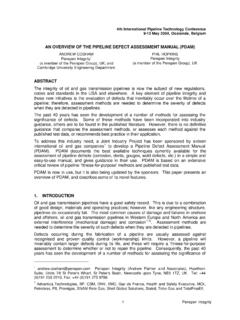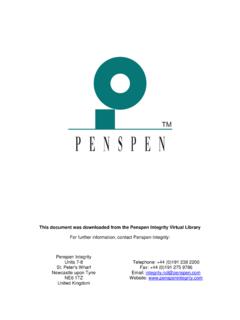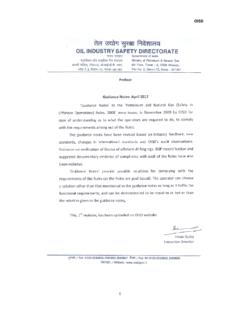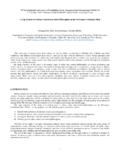Transcription of This document was downloaded from the Penspen …
1 this document was downloaded from the Penspen integrity Virtual Library For further information, contact Penspen integrity : Penspen integrity Units 7-8 St. Peter's Wharf Newcastle upon Tyne NE6 1TZ United Kingdom Telephone: +44 (0)191 238 2200 Fax: +44 (0)191 275 9786 Email: Website: UNDERSTANDING THE RESULTS OF AN INTELLIGENT PIG INSPECTION By, Roland Palmer-Jones, Prof. Phil Hopkins, Penspen integrity , Newcastle upon Tyne, UK, and Dr. David Eyre, Penspen integrity , Richmond, UK. 1 INTRODUCTION Intelligent pigs are used extensively for inspecting pipelines.
2 Their use has been increasing rapidly due to their proven benefits, expanding capabilities, and legislative requirements. The result of an intelligent pig inspection is an inspection report with a list of defects. To gain the full benefit from an inspection the pipeline operator must understand the inspection process, and what the list of defects means for the immediate and the future integrity of the pipeline. The Inspection Process Running an intelligent pig in a pipeline is a significant project with potential safety and operational implications. Any pigging operation should be carefully planned to ensure that the correct tool is used, that appropriate pipeline cleaning is carried out, the pig will not get stuck, contingency measures are in place to locate and remove a stuck pig, and that safe procedures for pig launch, receive, and handling are followed.
3 Guidance on managing an intelligent pig inspection is available[6]. Assessing Defects There are a number of recognised defect-acceptance (or fitness-for-purpose ) methods available for assessing these defects (for example ASME B31G, and API 579), but these methods are simply calculation methodologies; there are many issues related to the input data and the engineering assessment that also need to be resolved in order to have a full understanding of the pipeline condition. These include tolerances on pig data, the age of the pipeline, the product transported, the operation of the pipeline (cyclic pressures), thermal expansion loads, ground movement loads, and the type and cause of the defect.
4 Consequently, it is good practice to approach defect assessments holistically. this means that all aspects of the pipeline's integrity are taken into account, and it is not viewed simply as an exercise of inputting smart pig data into an equation and simply obtaining a predicted failure pressure for the defect. this paper provides a process for reviewing any set of inspection data, and gives some simple guidance on understanding the results of an intelligent pig inspection, based on examples for calliper, magnetic flux leakage (MFL), ultrasonic (UT) metal loss, and UT crack detection inspections.
5 Penspen Limited 2 OVERVIEW When the results of an inspection of a pipeline are received a staged process of review and assessment is recommended. this process is outlined in Figure 1. Level 2 integrity Assessment To fully understand the problem and consider whether pipeline is safe to operate in damaged Assessment Evaluation of inspection data and pipeline implications for future 1 integrity Assessment Confirm condition of line is satisfactory and set future inspection scheduleImmediate Expert Assessment Define requirements for shut down, or pressure inspection to confirm Assessment and repairs/rehabilitation or replacement as requiredConfirm defect identification.
6 And sizing with inspection Re-inspectionSevere defectsUnsatisfactory performanceSome or no defectsEvidence of a potential problemEverything looks OKVendorOperator and vendorLevel 2 integrity Assessment To fully understand the problem and consider whether pipeline is safe to operate in damaged Assessment Evaluation of inspection data and pipeline implications for future 1 integrity Assessment Confirm condition of line is satisfactory and set future inspection scheduleImmediate Expert Assessment Define requirements for shut down, or pressure inspection to confirm Assessment and repairs/rehabilitation or replacement as requiredConfirm defect identification, and sizing with inspection Re-inspectionSevere defectsUnsatisfactory performanceSome or no defectsEvidence of a potential problemEverything looks OKVendorOperator and vendor Figure 1 Assessing Intelligent Pig Data 3 INSPECTION There are now published standards that help operators through the intelligent pig inspection process NACE RP 0102-2002[1]; API 1163[2]; and ASNT ILI-PQ-2005[3].
7 In addition there are standards such as API 1160[4] and ASME [5] that provide guidance on the selection of pigs for detecting particular types of defects. 4 PRELIMINARY ASSESSESMENT The first stage of assessing the results of an intelligent pig inspection is a review of the results by the pipeline operator, or their representative. this review has the following objectives; a) To identify any potentially severe defects requiring immediate action. b) To ensure that the inspection was successful, that is to ensure that data was collected for the required percentage of the line, and in particular that data has been collected for any locations that may previously have been identified as critical.
8 It may be that the performance was not satisfactory or did not meet the standards required by the contract. If this it the case, a re-inspection may be required. c) To confirm that there is no ambiguity over the defects reported, for example due to terminology such as crack like used to refer to defects. d) To confirm that the defects reported are credible. That is, they are expected or there is a reasonable explanation for their presence. For example, numerous rock dents are common in large diameter thin wall onshore pipelines; however, small diameter thick wall offshore pipelines should not contain a large number of dents.
9 E) Give a qualitative assessment of the condition of the pipeline: Are there many defects or just a few? this initial review does not require a high level of expertise in pipeline defect assessment or a detailed understanding of the inspection technology. It does require an appreciation of pipeline defects, what causes them and their significance. It also requires an appreciation of the capabilities and limitations of the inspection technology. this review should not be carried out by someone with limited experience of pipeline integrity management.
10 If severe defects are reported, then immediate action will be required. this may be an immediate shutdown or pressure reduction, or rapid expert evaluation to consider the need for shutdown or pressure reduction. The significance of defects will depend on the pipeline design, materials and operation. Severe defects include: Corrosion (or any metal loss) more than 80% through the pipe wall. Dents (or bore reductions) greater than 6% of the pipe diameter. Dents with associated gouging (metal loss), or cracking. Dents on seam or girth welds of poor quality.






